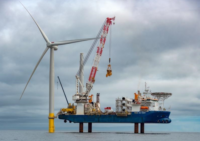...project participant on Disney. “It was the single-largest commitment of talent we ever put on one job, but what we got out of it was a completely new way to build.”
BIM is now a key component of a current Mortenson project, the $288-million TCF Bank stadium in Minneapolis for the University of Minnesota Gophers football team. Even the contractor’s most rough-and-tumble site managers are now disciples, including Senior Superintendent Randy Schnieders, a 26-year veteran who started as a carpenter. “I am amazed at what we can do with this,” he says, noting the technology’s ability to find minor design conflicts that would have thrown off alignments in the facility’s extensive steel-and-concrete skeleton. “I didn’t know what to expect with 3D, but I like this new technology.” Schnieders adds that it has prevented expensive rework and lowered workers’ injury risk.
More Information
 Debra k. Rubin / ENR Mortenson with sons Mark (left) and David, the latter set to inherit firm’s leadership mantle
|
Construction executive Paul Kitching, an 11-year veteran of the firm, says the models provide subs more information to prepare better bids and offer the owner a truer sense of cost. “BIM takes out the daily fires you have to fight,” he says. The fast-tracked project, which has two full-time modelers on staff, is set to open in August 2009, one month before the team’s first game. Noting Mortenson’s expertise in sports facility construction, “we have never missed an opening day,” says Schnieders.
The two project managers are among employees convinced that Mortenson will satisfy their career aspirations for a long time. They include second son, Mark, 42, its chief investment officer. The next generation insists it joined the firm out of excitement, not obligation, saying that two other sons are pursuing careers outside Mortenson, “with no pressure to join,” says David.
 M.A. Mortenson Co.
|
 M.A. Mortenson Co, Mortenson is biggest U.S. wind-power builder (top); Jacksonville, Fla., Navy aircraft hangar is part of booming military-federal niche.
|
But mostly everyone else at Mortenson doesn’t want to leave. Virtually all top execs are homegrown veterans with 25 years of service, on average. The firm is well-capitalized enough by its family owners to avoid the public market and does not plan to expand ownership to employees. But few seem unhappy with its rewards, financial or otherwise. Senior leaders get incentives tied to performance, and there is strong emphasis on training, entrepreneurship and culture-building.
Patrick F. Burns, a retired brigadier general and former engineering director for the U.S. Air Force’s Air Combat Combat Command, was widely recruited by industry firms when he left military service in 2005. He opted to join Mortenson as a vice president in its federal group. “Theirs was not the highest offer, but they asked me not what I might contribute to the profit line but how I’d fit into the company,” he says. Derek Cunz, the firm’s director of project development and a much-recognized Disney concert-hall veteran, notes that Mortenson’s embrace of BIM has created a new employee career-development path. “Our pace is fast,” he says. “You have to be prepared.” Gunkel says new recruits “want to be empowered, have responsibility and have someone invest in them.”
 | They asked me not about profit but how I would fit. — PATRICK F. BURNS, V.P.,
FEDERAL SERVICES |
Employees do leave the fold, with some able to spread the Mortenson mantra into the industry. Steve Halverson, a Minneapolis native, was on the executive track but left after 15 years to become CEO of Jacksonville, Fla.-based Haskell Co. “I have great affection for the place and always will,” he says. “They’re the most operationally disciplined firm in the business. Despite their conservatism, Mortenson is not afraid of the future.”
 |
| SPONEM |
The contractor has refreshed the executive ranks with its first woman near the top, Chief Financial Officer Sandy Sponem, who joined in 2007 from a local investment banking firm. Mortenson’s dearth of executive diversity is not new to her. “Investment banking is male-dominated in the senior ranks,” she says. “I’m comfortable in that environment.” She now expects to finish her career at Mortenson, noting that her expertise in planning and analysis will help the firm forecast future markets and growth.
That could get trickier as changing economics impact traditional markets. Mortenson executives predict a slowdown in municipal work and possible revenue decline next year but say a strong and diverse project backlog and lack of developer-led projects will sustain the building sector. Mort Jr. says the company may expand to Texas next year.
 Debra k. Rubin / ENR Superintendent Schnieders (left), a former craft worker, and project exec Kitchings, embrace BIM at jobsite.
|
New energy projects, particularly renewables, are a more promising field, especially with new federal incentives now anticipated. Mortenson is already the leading developer of wind-power projects in the U.S., and holds several design patents. The firm’s headquarters’ energy use is 100% derived from wind, says Gunkel. “We have a highly motivated green team,” he says.
Booming military construction work will also help. Mort Jr. says the firm has treated federal-sector work, a dedicated niche since 1986, not “as a market of convenience.” The firm is now building the Navy’s largest aircraft hangar in Jacksonville, Fla.
The contractor has looked across borders for work, but its appetite for risk has some limits. Mortenson opted not to set up shop in trendy Dubai or India, only going abroad when asked by U.S. clients. A foray into Australia was unsuccessful, but sources say it is still eyeing the continent, possibly for energy work. The one overseas exception is China, where the company was lured by customers. Mortenson is now building about 150 “learning centers” for Disney as it seeks to become
China’s primary purveyor of English education. Perhaps there is more to come. Mort Jr. says he views Beijing’s so-called Bird’s Nest Olympic stadium with envy: “That looks like something we would have liked to do.”







